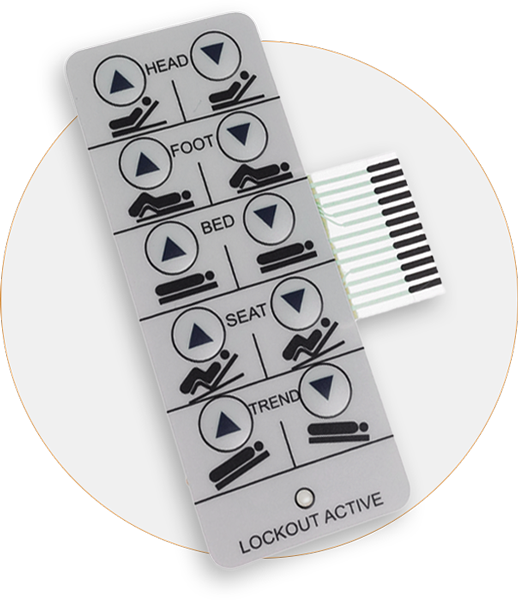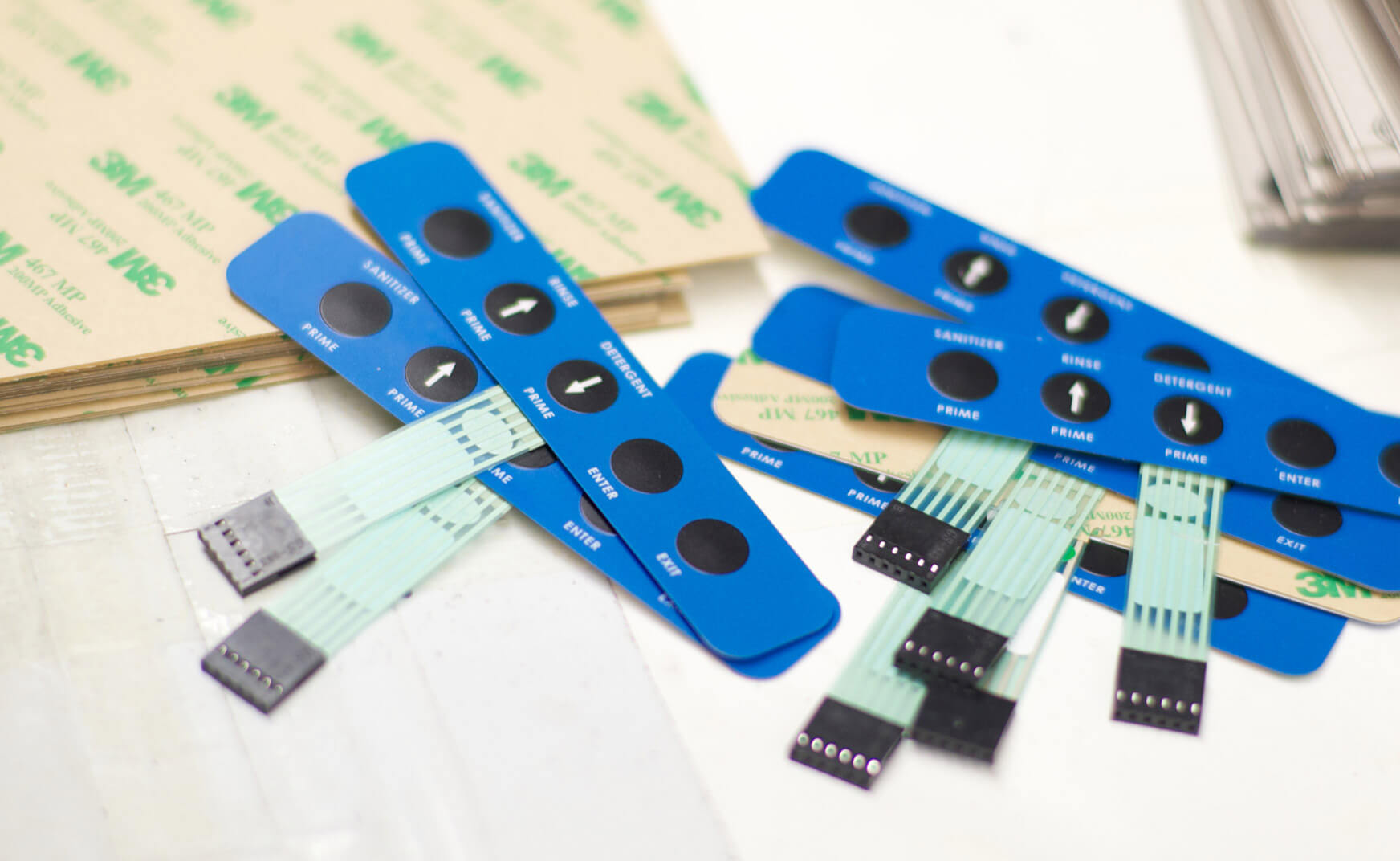Why Selecting the Right Membrane Switch Is Crucial for Your Item Style
Why Selecting the Right Membrane Switch Is Crucial for Your Item Style
Blog Article
Just How Membrane Changes Contribute to the Longevity of Electronic Control Panels
Membrane layer buttons play a vital role in enhancing the toughness of digital control board, largely through their multi-layered building which offers reliable defense versus environmental elements such as wetness and dust. This style not just lessens the threat of circuit damage and rust yet additionally promotes ease of maintenance as a result of its seamless surface area. Additionally, the lack of relocating components substantially lowers the likelihood of mechanical failings, making membrane layer switches ideal for requiring applications. Nevertheless, the ramifications of these functions prolong past simple security, questioning concerning their wider influence on capability and customer experience.
Meaning of Membrane Switches

Membrane layer switches are developed to be slim and lightweight, making them suitable for applications where space is limited. They can be produced in different forms, dimensions, and shades, offering versatility in style that fulfills aesthetic and useful demands. Furthermore, membrane layer buttons can include various modern technologies, such as tactile comments and LED indications, boosting customer experience.
As a result of their building and construction, membrane layer switches are commonly immune to dirt, wetness, and general wear, adding to their toughness popular environments. Their seamless design not only helps with simple cleaning but also reduces the risk of mechanical failure, making them a recommended option for manufacturers looking for reliable user interfaces in their electronic control panels.
Protection Against Ecological Elements
The design of membrane layer switches naturally gives a level of security against various ecological aspects, which is essential for keeping functionality in tough problems - Membrane Switch. These buttons are typically created with layers of versatile products that secure interior parts from wetness, dust, and contaminants. By enveloping the circuitry, membrane layer changes decrease the danger of short circuits and corrosion, which can substantially impair efficiency
Furthermore, the usage of robust adhesives and sealants throughout production boosts their resistance to environmental obstacles. Membrane switches can sustain exposure to chemicals and solvents, making them ideal for markets such as food handling and health care, where hygiene and sanitation are extremely important. Their smooth surface layout likewise prevents the buildup of dust and microorganisms, facilitating much easier cleansing and maintenance.
Temperature level variations are one more environmental concern, and membrane layer buttons are crafted to work effectively across a large range of temperature levels (Membrane Switch). This versatility makes certain that control board stay functional in numerous settings, from industrial atmospheres to customer electronics
Effect on Customer Interaction
User interaction with electronic control board is considerably affected by the layout and functionality of membrane buttons. These switches supply a responsive user interface that enhances the overall individual experience, enabling instinctive navigating and control. Their receptive nature guarantees that individuals get prompt feedback upon activation, which is essential for jobs needing accuracy and performance.
In addition, the smooth surface of membrane layer switches assists in easy cleansing and maintenance, advertising individual confidence in the dependability of the interface. This tidiness is specifically vital in environments where hygiene is paramount, such as medical or food handling settings. In addition, the compact and lightweight design of membrane layer switches over adds to the aesthetic charm of control panels, encouraging user engagement via why not find out more a modern-day and streamlined look.
Furthermore, the integration of visual components, such as published icons and backlighting, assists individuals rapidly identify features, lowering the discovering contour connected with brand-new devices. Because of this, users can run gadgets better, causing boosted efficiency and fulfillment. In recap, membrane layer buttons play a critical duty in improving user communication by integrating capability, appearances, and simplicity of use, inevitably resulting in improved functional efficiency.
Design Adaptability and Personalization
Layout versatility and customization are necessary elements of membrane buttons, enabling makers to tailor digital control panels to details applications and user demands. This adaptability permits the integration of various style elements, such address as colors, graphics, and textures, which can boost the visual charm and customer involvement of the control board.
Membrane switches can be customized in shapes and size, accommodating a vast variety of tools and applications, from industrial equipment to customer electronics. This adaptability makes certain that producers can develop user-friendly user interfaces that straighten with individual assumptions and operational demands. In addition, the ability to integrate unique features such as backlighting or tactile responses even more improves functionality, permitting for a more interactive experience.
Furthermore, the manufacturing process for membrane layer switches over sustains the fast prototyping of designs, making it possible for producers to iterate and fine-tune their ideas swiftly. This capacity not just speeds up the growth timeline yet additionally makes certain that the end product fulfills particular useful and visual requirements.

Cost-Effectiveness and Longevity
Cost-effectiveness and longevity are significant advantages of membrane layer buttons, making them an eye-catching choice for makers and end-users alike. These switches are commonly much less pricey to create than conventional mechanical switches, primarily as a result of their simplified production procedures and the decreased number of parts needed. special info This expense benefit prolongs not only to initial production however also to long-term operational costs, as membrane layer switches frequently need much less upkeep and have a reduced failing price.
Furthermore, the longevity of membrane switches over adds to their overall value. Created from sturdy materials, they are resistant to ecological elements such as moisture, dust, and chemicals, which can cause premature wear in various other switch types. The lack of moving components lessens mechanical failing, permitting membrane layer changes to keep performance over extended durations.
This longevity is especially useful in applications requiring constant efficiency under demanding conditions, such as medical gadgets and commercial equipment. Eventually, the combination of cost-effectiveness and durability makes membrane switches over a financially sensible choice for producers, providing trusted remedies that endure the examination of time while enhancing financial factors to consider.
Verdict
In conclusion, membrane buttons dramatically improve the sturdiness of digital control panels through their robust construction and safety attributes - Membrane Switch. Overall, membrane layer switches over represent a dependable and cost-effective selection for enhancing the long life and functionality of electronic control systems.
Report this page